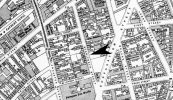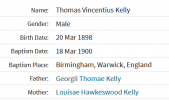Hello,
Realise that this is an old post but I have just registered today.
I am one of the WW1 researchers at the Worcs Regt Museum and the custodian of the Worcs Regt WW1 database.
This is Thomas's entry in our database - sadly no photo
Promenade
-----------------------------------------
KELLY, Private, THOMAS, 14076. 3rd Bn. Worcestershire Regt. 28 April 1916. (Arras Memorial - France)
Husband of Kate Kelly (b. 13/4/95) of 2 court, 4 house, Stainforth St, Birmingham [cannot find a Stainforth St - only a Staniforth St [see attached from 1913 OS Map] - almost all of this area has been redeveloped). Father of Kathleen Rose Wallace b. 17/2/15 before wedlock. (Fold3 - Ancestry)
To France 21/12/15 as part of a reinforcement draft
Born in Birmingham.
Enlisted in Birmingham on, or close to, 18/8/14.
3rd Battalion.
4.8.14 Tidworth: 7th Bde. 3rd Div.
16.8.14 landed at Rouen.
18.10.15 7th Bde. to 25th Div.
10.11.17 to 74th Bde. 25th Div.
22.6.18 to 57th Bde. 19th Div. absorbing 10th Bn.
11.11.18 57th Bde. 19th Div. France; west of Bavai.
Extract from 3 Worcs War Diary
26/4/16
Battalion relieved 10th CHESHIRE Regiment from trenches North East of MONT-ST-ELOY. Wounded 2 other Ranks.
27/4/16
In trenches. Enemy’s artillery active on communication trenches during day and night. Wounded 1 Officer 3 other Ranks. Killed 1 other Rank.
28/4/16
Enemy exploded mine under left Company’s (D Coy) outpost line, they entered the trench but were driven out. The mine exploded about 7.15pm. 6 other Ranks killed, 14 other Ranks missing, believed killed. 47 wounded.
29/4/16
Two platoons of A Company, supported by two platoons of B Coy, were ordered to gain and consolidate near lip of crater of mine exploded on the 25th inst. The result was made at 8.15pm after artillery preparation, but owing to very heavy machine gun and rifle fire from crater, no headway was made. No second attempt was made at 1.45am with the same result. Killed - 1 Officer and 7 other Ranks. Missing (BD) 2 other Ranks. Wounded - 1 Officer and 42 other Ranks
30/4/16
In accordance with instructions from G.O.C. 7th Inf Bde that it was essential to gain and consolidate the near lip of a crater in front of left centre Company’s outpost line, an assault was made by a party of 30 other ranks and one officer to C Company, supported by 2 Lewis Guns. The enemy retired and the near lip was gained and consolidated. Wounded - 6 other Ranks. Killed - 1 other Rank.
Extracted from Regimental History [Stacke] p155-6
Crater Fighting on the Vimy Ridge
For a week after their arrival in the area north of Arras [10/4/16], the 3rd Worcestershire remained in reserve. One company was detached to Anzin St. Aubin and one to Roclincourt, and throughout the week the whole Battalion was split up in working and carrying parties, to assist the mining operations in the front-line trenches. Until April 19th, those parties laboured separately, with many minor adventures; then the Battalion was reunited in Divisional Reserve at Acq. On April 26th the Battalion moved forward and relieved the 10th Cheshire in the line just north of Neuville St. Vaast, half-way up the slope of the Ridge.
The front line ran across a wilderness of mine craters and both sides were working feverishly on the construction of fresh mines. Shell-fire was incessant. On the first day there were several casualties (1 killed, 5 wounded) including the Medical Officer of the Battalion. That evening a minor enterprise carried out by two officers of the Regiment, Major A. C. Johnston (then Brigade Major) and Captain G. S. Briscoe, succeeded in establishing a post on the near lip of 'Broadmarsh Crater' a point previously unreached.
The following day (April 28th) was broken only by sniping and bombing around the new post. Nothing much occurred until darkness fell. Then, at about 7.30 p.m. a terrific explosion shook the ground. A huge mine had been exploded by the enemy under the parapet near the left flank of the Battalion's line. A storm of firing followed as the enemy attacked. The new post at "Broad-marsh Crater" was overwhelmed, but around the fresh crater formed by the explosion the bombers of the 3rd Worcestershire fought stubbornly. The defence was inspired by 2/Lieut. J. D. W. McMichael and by Captain T. P. Muspratt who, although severely wounded, refused to leave his company, and continued in command during four hours of heavy fighting until the danger had passed. Captain Muspratt was awarded the M.C. and Pte. A. G. Boothman, who showed great bravery in this fight, was awarded the D.C.M. The enemy seized the crater but their further advance was checked. Casualties, 3rd Worcestershire - 6 killed, 14 missing believed killed, one officer (Captain T. P. Muspratt) and 47 men wounded.
From the near lip of the new crater "Central Crater," as it was named, from its position at the head of a trench called "Central Avenue" - the enemy could overlook all the vicinity. The situation would be most dangerous unless they could be driven back. Plans for counter-attack were made, artillery support was arranged and after dark the force detailed for the counter-attack, two platoons under Captain T. G. Parkes, formed up in "Bertrand Trench."
At 8-15 p.m., amid soaring flares and bursting shells, the two platoons charged forward. They were met by an intense machine-gun fire from both flanks and from the crater itself. Through the storm Captain Parkes succeeded in winning his way to the lip of the crater, but there found himself accompanied only by one subaltern (2/Lieut. H. A. Jennings) and one private. Every other man of his two platoons had been struck down. The enemy were strongly posted, and were firing with four machine-guns from the crater's near edge. The three survivors could do no more than reconnoitre the position. The subaltern actually made his way into the crater. Then they crept back to Bertrand Trench to arrange a fresh assault.
The bombardment by the artillery had done little damage, and apparently had served merely to warn the enemy. It was decided therefore that the renewed attack should be made in silence and without artillery support until the enemy should open fire. Two hours after midnight the second attempt was made by the other two platoons of the Company. Creeping forward with the bayonet, the assaulting platoons got within twenty yards of the crater; but there the attack was held up. In the time which had elapsed since the first attack the enemy had hastily covered their front with barbed wire, and in the darkness the troops could not pass that entanglement. The enemy's machine-guns opened fire, 2/Lieut. Jennings, who throughout showed the greatest gallantry, was killed and the attack was brought to a standstill. Most of the two platoons had fallen, but the surviving subaltern, 2/Lieut. R. B. W. Vintner, reorganised such as remained, found a gap in the wire and made his way forward to within bombing distance. Six brave men followed him, and hurled bombs at the enemy's machine-guns till they had no more to throw. The subaltern was wounded (7 killed, 2 missing believed killed. 2/Lieut. Vintner was awarded the M.C.), and the remnant of the attackers were forced to fall back. In those two attacks Captain Parkes company had lost 1 officer (2/Lieut. H. A. Jennings) and 9 men killed, 1 officer (2/Lieut. R. B. W. Vintner) and 38 men wounded.
At the same time the right flank company of the Battalion, under Captain J. B. Barron, endeavoured to regain the lost position in "Broadmarsh" Crater. But after a sharp bombing fight the attacking platoon was forced to fall back after losing 2 killed and 11 wounded. Colonel Davidge then decided that success was unlikely without a thorough artillery preparation and postponed further operations.
Next day (April 30th) the artillery of both sides were very active, and it was decided again to attack "Broadmarsh" Crater. The attacking party, 32 volunteers from Captain Barron's company under 2/Lieut. H. U. Richards, crept forward in silence from Broadmarsh Trench at 1.40 a.m., surprised the enemy and seized the near lip of the crater. Amid a blaze of firing from every direction they dug themselves into cover, and by dawn the near edge of the crater was securely in our possession at no greater cost than three men wounded: a gratifying little success.
On the following evening (May 1st) the 3rd Worcestershire were relieved by the 10th Cheshire and marched back into reserve billets by Mont St. Eloy, whence during the ensuing week many working parties were sent forward (the working parties were shelled. Casualties 2 killed, 1 wounded).



